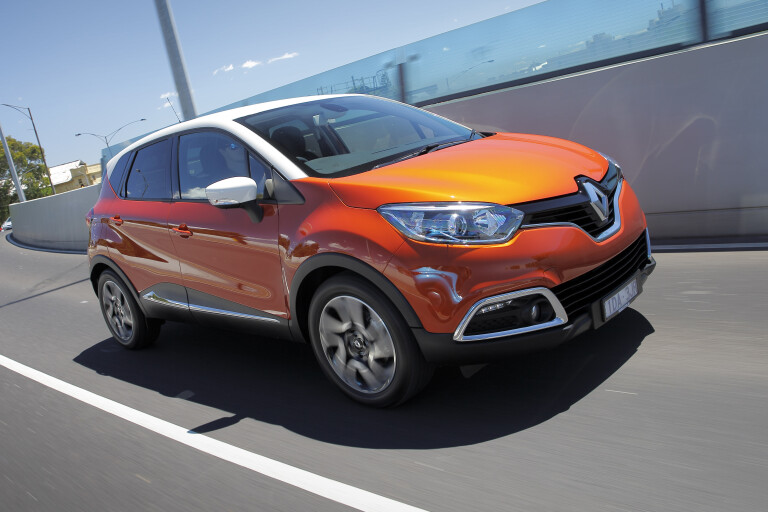
Renault’s foray into the booming world of front-drive light SUVs brings real style and efficiency to a patchy competitor set, while also appealing to those who like low prices and high specs. No wonder it's going gangbusters globally.
WHAT IS IT?
Built in Spain, the current Clio-based Captur follows the class norm in being front-drive and petrol-powered only (for now), slotting beneath the ageing Koleos in the Holden Trax/Mazda CX-3 market segment. Remarkably, Renault really got the spec right, with the Captur ticking all the necessary boxes, then adding a few extras.
WHY WE'RE TESTING IT
Since the current rash started arriving a couple of years ago, the B-segment SUV brigade has hardly consisted of overachievers, but suddenly three hopefuls are here to change things for the better. The Renault Captur has been selling up a storm abroad; will it do the same against the promising new Mazda CX-3 and Honda HR-V?
MAIN RIVALS
Ford EcoSport, Holden Trax, Honda HR-V, Mazda CX-3, Nissan Juke, Peugeot 2008, Skoda Yeti, Suzuki S-Cross
THE WHEELS VERDICT
After the chunky little Clio, Renault’s gets it right again with the Captur. No other light SUV in Australia quite hits the same high notes, particularly in terms of design, packaging, driver enjoyment, efficient drivetrains and features for the money.
PLUS: Design; packaging; value; comfort; connectivity; efficiency; warranty
MINUS: Sluggish acceleration; rear drum brakes; no diesel or 0.9L turbo auto
THE WHEELS REVIEW
IS IT May 2014 yet? That’s when we expected to see the Captur here, but massive demand and production constraints delayed the compact SUV by nine months.
Renault denies it delayed the local launch because the lack of rear-seat airbags would have resulted in only a four-star ANCAP crash rating. It now scores five stars due to changes in the scoring system introduced on January 1.
The Spanish-built Renault Clio-based crossover still feels fresh in the face of its rivals.
A runaway Euro bestseller, the front-drive-only Captur has a few aces up its sleeve. For starters, the design from ex-Mazda doodler Laurens van den Acker is appealing. Neat, well proportioned and with just a hint of individuality in the two-tone roof treatment and lower-sill trim kink, the Renault ought to sell on styling alone.
Perched some 100mm higher than the Clio that spawned it, the Captur’s solidly presented interior is both roomier and more versatile than most, with an unusually agreeable layout for a French car.
Top marks for a comfy driving position on plump cushions, ample ventilation, excellent instrumentation, plentiful storage and one of the simplest touchscreen multimedia systems around.
There’s just nothing confronting here – unless in the always dubious pursuit of ‘personalisation’, buyers take up the option of staining the handsome cabin with streaks of dayglo-like colour that appear to be applied with a paintball blunderbuss. At least the accompanying seat covers can be unzipped and washed… or swapped for something less garish.
Fat A-pillars can hinder forward vision, but otherwise the Captur’s cabin continues to score with enough rear-seat space for adults, on split/fold rear seats that slide to boost either legroom or luggage capacity. Cargo space is 377-455 litres with backrests erect, increases to 1235 litres with them folded, and benefits from a clever multi-configurable floor with wet/dry area compartmentalisation.
A pair of modern drivetrain offerings brings lively and efficient if not scintillating performance to the Captur’s long list of attributes.
About 20 percent of buyers are expected to choose the base Expression TCe 90 manual powered by what is a lusty little three-cylinder turbo in the Clio equivalent. It’s burdened by the extra 100kg of the Captur, but still accelerates with more vigour than the 0.9-litre capacity suggests, and pulls away strongly once the engine revs hit their stride.
The manual is a rather long-throw five-speed and, sadly, no auto option is available with the triple, necessitating a step up to the Expression or range-topping Dynamique fitted with a 1.2-litre four-pot turbo (dubbed TCe 120) and six-speed dual-clutch transmission.
While the larger-engined Captur is quiet, smooth and surprisingly punchy once the revs are up, momentary off-the-line lag, accompanied by a strange graunchy sound, undermine its low-speed driveability, as is the case with most dual-clutch arrangements.
The extra mass and increased ride height (163mm ground clearance) also blunt steering responses compared to the Clio, but relative to its rivals the Captur remains an eager and poised handler, with taut levels of body control over all manner of bumpy terrain. The base 16-inch wheels soak up bumps better than the firm-ish 17-inch set-up, though overall the Renault remains a civilised and quiet ride.
From $22,990, the Expression TCe 90 manual is sharply priced, yet throws in sat-nav with touchscreen, auto headlights and wipers, climate control, keyless entry, reversing camera, rear sensors, alloys, capped-price servicing and a five-year warranty with roadside assist.
The auto and TCe 120 engine adds $3K more, which still puts it $200 under the popular Trax auto.
Keen to clean up in the compact SUV class, the Captur is Renault’s most important release in years. We reckon the wait’s been worthwhile.
SPECS
Model: Renault Captur TCe 120 Dynamique
Engine: 1197cc 4cyl, dohc, 16v, turbo
Max power: 88kW @ 4900rpm
Max torque: 190Nm @ 2000rpm
Transmission: 6-speed dual-clutch
Weight: 1215kg
0-100km/h: 10.9sec (claimed)
Economy: 5.4L/100km
Price: $27,990
On sale: Now

COMMENTS